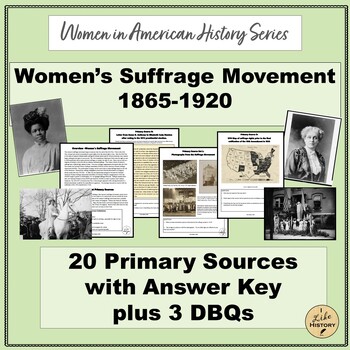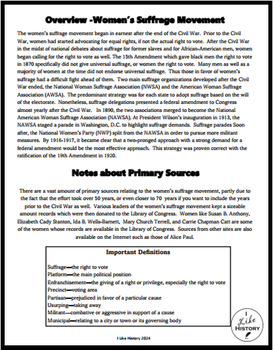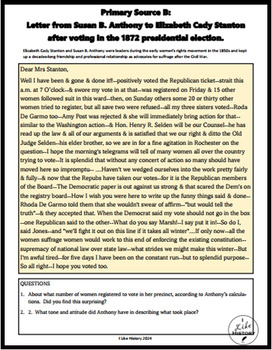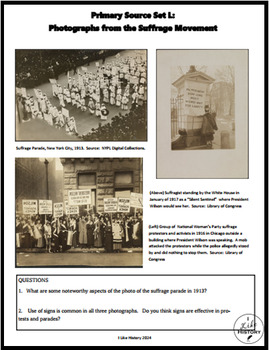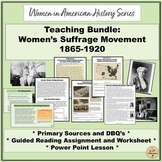Women's Suffrage: DBQ's and Primary Sources *APUSH*
- PDF
- Easel Activity
Also included in
- Women's Suffrage in the United States: 1865-1920 Teaching Bundle Resources:* Primary Source Analysis and DBQ's* Power Point Lesson* Reading Assignment and Worksheet (Guided Reading)Primary Source Analysis and DBQ'sThis 29-page Primary Source Analysis with DBQ's resource with 20 primary sources plusPrice $11.25Original Price $12.50Save $1.25
Description
This 29-page resource with 20 primary sources plus three DBQ prompts gives students a chance to delve deeper into the challenges, obstacles and finally the success of the suffrage movement. The first page includes an Overview, Notes on Primary Sources and Definitions.
Here’s a chance for students to read documents that shed light on various opinions in favor and against suffrage, the differences of opinions within the movement as to strategy and how racial segregation played a role in the movement.
Assign just one, a few or all of the sources depending on time constraints and student interest.
Primary sources include letters, photos, reports and other documents. Each page of primary sources includes questions at the end in order for students to analyze perspectives, consider key ideas and identify bias.
Included is a one-page sheet that explains what primary sources are and how to analyze them using specific questions through a process called HAPPY. There is also a page at the end for students to apply the HAPPY process to one source.
Three DBQ prompts are included at the end with instructions on how to create a response to the prompt. An Answer Key to all the questions and the DBQ prompts are available at the end of the packet.
This is excellent practice for all high school students, particularly Honors and AP students, but all students will find these resources engaging.
This is also available as a digital resource through Easel so students may complete it online.
Please check out my other Primary Source Analysis and DBQ Teaching Resources about Women's History
* Women in Colonial America: DBQ's and Primary Sources
* Women of the American Revolution: DBQ's and Primary Sources
* Early Women's Rights 1840-1865: DBQ's and Primary Sources
* Women during the Industrial Era: DBQ's and Primary Sources
* Women in the U.S. Military during World War II: DBQ's and Primary Sources
More are always being added so check back frequently!
If you like World War II historical fiction, I have written a novel called Hearts of War featuring a Nisei soldier who served in the Military Intelligence Service as a translator and a woman who served in the Women Army Corps, both of whom were assigned to the Pacific theater. In writing this book, I wanted to bring an unknown aspect of history to light. Available on Amazon or Kindle. Appropriate for Young Adults/Adults. I appreciate any reviews!
Thank you!
Christa Nonnemaker

